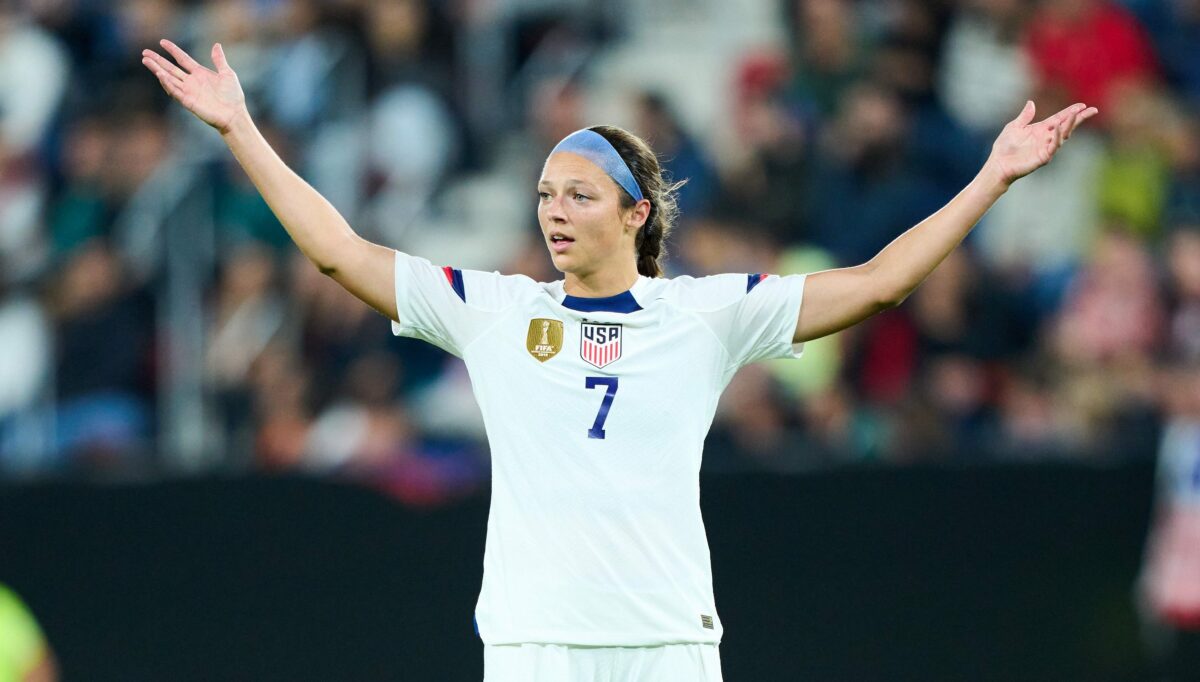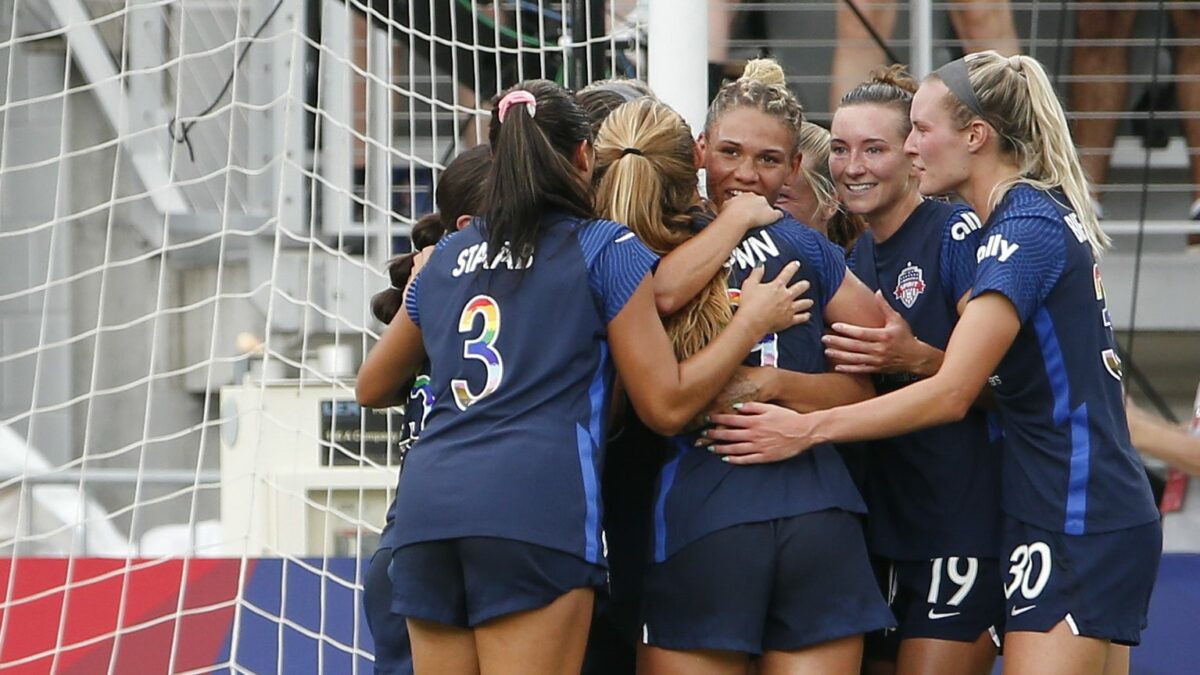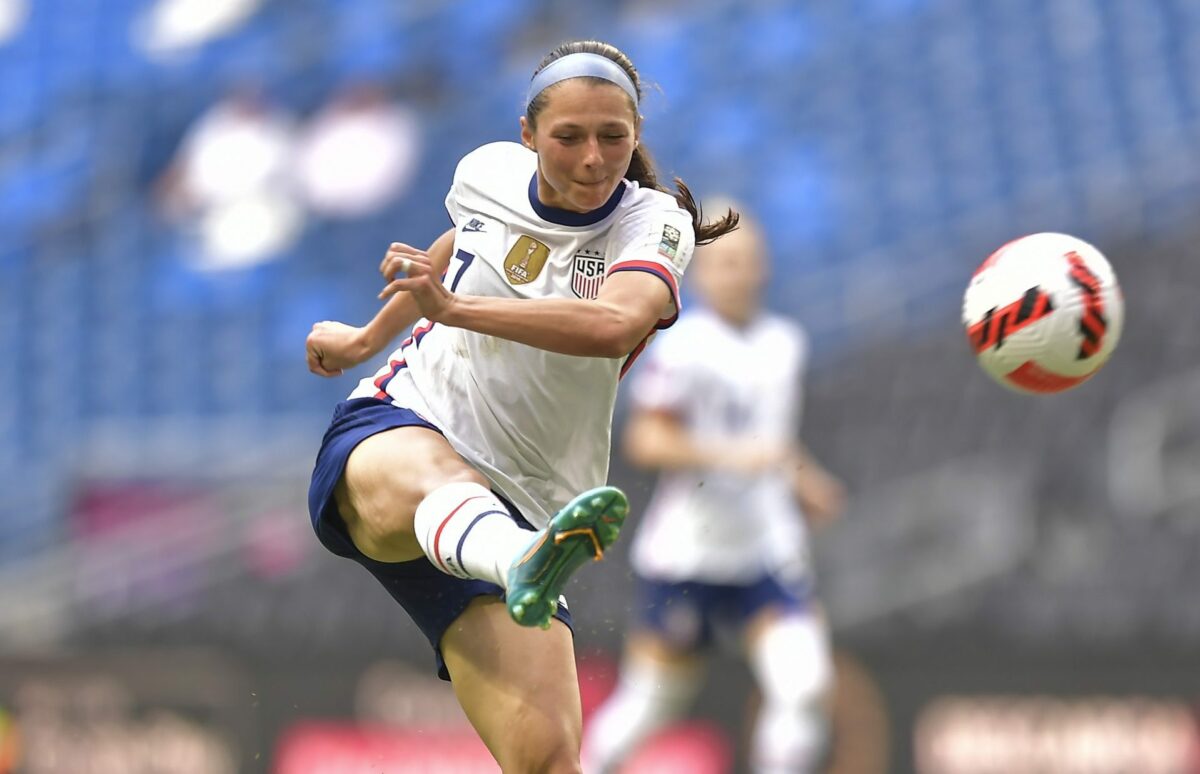As Tuesday night’s U.S. women’s national team friendly against Colombia became Wednesday morning’s 2-0 win, things got weird. The goals both came from the USWNT’s right backs, a late storm delayed the game by nearly an hour, and of all people Ashley Hatch ended up in a shoving match.
Amid all of that, the USWNT faced a slightly different, more open version of Colombia than they did in Saturday’s first meeting, and the game was a tougher task. Alyssa Naeher, starting in the second game, had a few moments to worry in a way that game one starter Casey Murphy didn’t, and while the USWNT were worthy winners, it wasn’t exactly a smooth path.
That path can be summed up in three moments, so let’s dig into what we saw Tuesday night:
Tactical gambits?
Vlatko Andonovski caught Colombia out with two really interesting experiments in the first game: going with two No. 10s from halftime on by bringing Ashley Sanchez in, and a late move to try Kristie Mewis as a No. 6.
The double-ten was put out there from the start in Utah, with Lindsey Horan starting underneath Sanchez and Rose Lavelle, but while the move broke the game open as a halftime adjustment, things weren’t so easy when used from the start.
What was the difference? For one, Colombia simply wasn’t fatigued from defending for 45 minutes, and they got the chance to adjust to the rhythm the U.S. set with two attacking midfielders from kickoff rather than having to figure it out on the fly. With the Colombian line of contention higher, Sanchez and Lavelle had less room to turn and face goal.
Neither played badly, but rather than the revelatory bunker-busting look we saw in Colorado, the USWNT were not quite able to stretch Colombia enough. It was a game of “almost” for the USWNT attack, with Colombia’s center backs frequently doing just enough with their emergency defending to keep true danger at bay.
Mewis, meanwhile, was the subject of some Colombian adjustment to U.S. tactics. Namely, their central midfielders tried to lure her out of her position as the midfield anchor to open up room for counters. Mewis, a natural No. 8 who can play further forward, still has the decision-making instincts of someone who generally plays with one more midfielder staying home. She wanted to step—for good reasons, as winning the ball on a counter-press can create excellent scoring chances—but sometimes stepped into the trap Colombia set for her.
None of this is to say the USWNT should discard either of these ideas. Sanchez and Lavelle have both developed such defensive engines that they can be deployed in this 4-3-3 formation together without being an irresponsible choice. Mewis’ long-range distribution remains a weapon, and between the lack of true defensive midfield options to give Andi Sullivan a rest and the prospect of some CONCACAF teams not being as savvy as Colombia were on Tuesday, it stands to reason that she will be better in this role if it comes up again in the W Championship.
Gamesmanship test
CONCACAF has a reputation for being a real test for a favorite’s ability to withstand provocation, and the USWNT should expect teams to look to get under their skin. It’s a great way to narrow the gap in terms of talent and experience, and while U.S. fans may not enjoy it, it’s a part of the game the USWNT has to be good at.
You can’t say they were particularly good at it against Colombia, though. Obviously the memes tell the story of the late-game clash between Ashley Hatch and Jorelyn Carabalí, a situation that saw Carabalí shoulder-check Hatch after the ball was gone, shoves exchanged, and eventually Hatch pushing Carabalí away with a hand to the face.
Referee Katja Koroleva gave Hatch a yellow and had no card for Carabalí, which means she didn’t follow the Laws of the Game for either player. In the W Championship, this hands-to-the-face moment could have easily resulted in a red card for Hatch, which is the actual punishment for this infringement.
The thing is, though, that Hatch wasn’t the only player to put a hand on an opponent’s face. Taylor Kornieck did the same in the first half, trying to evade some particularly grabby marking on a corner, a play that drew no attention from the referees at all. Early in the game, ESPN’s cameras focused in on Alex Morgan looking visibly frustrated with some aggressive pre-corner kick contact as well, though to her credit, she kept her hands to herself.
These are big learning experiences for the newer USWNT players, as they’re not going to get the more collegial treatment from defenders that we see in NWSL (where opponents are your former college/YNT teammate on a pretty regular basis). Not falling for the provocation should be a key talking point within the group over the next few days.
Reset button
That aforementioned lightning delay came at a pretty good time for the USWNT, who had only a top-notch Naeher save to thank for the scoreline still being 1-0 at the time. Colombia were finding some promising counter-attacking opportunities, and though the USWNT had somewhat regained their footing from around the 70th minute, their grip on the game had still loosened in the middle portion of the second half.
The USWNT came out from the break looking like they’d sorted everything out. They came back out with a high press that completely threw Colombia off, ramping the tempo up and pinning their opponents back deep. Within around 100 seconds, they put the game to bed with a powerful Kelley O’Hara strike.
For one thing, a quick side note about our first moment: Mewis and Sanchez were a factor here, and that’s a reason for the coaching staff to continue to looking at them for more time in these roles.
But more to our point here, the USWNT wasn’t going to regain their footing in this fashion so easily had that storm cell broken up before hitting Sandy, Utah. It’s a big stretch to say Colombia were definitely going to equalize, but they had gotten a couple of corner kicks and were rounding into a threat, and that’s not what the USWNT wants when 1-0 up in the final 20 minutes of a game.
The good news here is that the break provided a chance to learn in the locker room, and put those ideas into practice soon thereafter. The bottom line? There are some important lessons in a game like this, but it’s vital for the USWNT learned them in Utah rather than still needing to learn them down in Monterrey next week.
[lawrence-related id=3927,3874,3852]




